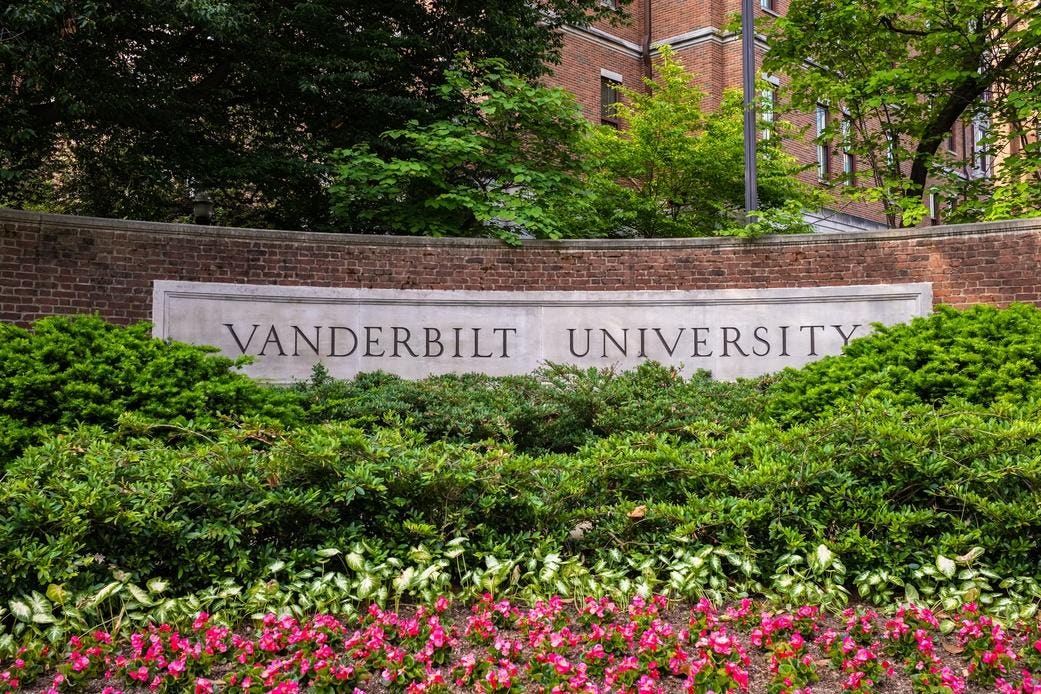Nashville, Tennessee USA – May 10, 2022: Entrance sign to the private research school Vanderbilt … More
The private prison industry did not emerge fully formed from a corporate boardroom. It was seeded quietly, often indirectly, by capital from university endowments. American universities, as institutional investors, have long shaped emerging markets by deploying billions through private equity, hedge funds, and index‑tracking portfolios.
At the time, these decisions drew minimal public scrutiny, guided by fiduciary responsibility, and framed as financially neutral. But universities’ expanding financial footprints have exposed them, directly and indirectly, to sectors with profound social implications. Now, amid growing demand for transparency and responsible investing, students, faculty, and alumni are asking: What systems have our institutions funded, and at what cost?
Seed Money and the Rise of Private Prisons
The modern private prison industry traces back to the early 1980s, when governments sought alternatives amid rising incarceration rates. The model: privately operated correctional facilities financed through government contracts. In 1983, Corrections Corporation of America (now CoreCivic) was launched by former Chairman of the Tennessee Republican Party, Thomas W. Beasley, with formative investments that included Vanderbilt University, the Tennessee Lookout reported.
Three years later, CoreCivic executed its initial public offering (IPO) in October 1986, listing 2 million shares on the NASDAQ under the ticker symbol CCAX at an offering price of $9.00 per share. In December 1994, the company transitioned its listing to the New York Stock Exchange, where it began trading under the symbol CXC, signaling its maturation into a more established publicly traded entity.
Today the corporation runs over 100 facilities nationwide. According to its 2024 Annual Report, the company reported $2.0 billion in revenue and $68.9 million in net income. CoreCivic continues to derive a significant portion of its revenue from federal contracts, including those with U.S. Immigration and Customs Enforcement (ICE), which has expanded to support mass deportation efforts of the Trump administration. Its main competitor, The GEO Group, earned $2.424 billion in revenue and reported $31.97 million in net income in 2024, as detailed in their 2024 Annual Report.
ETF Exposure and Indirect Investment
Although universities like Vanderbilt have since disavowed direct holdings in private prison companies, indirect exposure remains hidden within passive index funds. Universities may retain quiet financial ties bundled into the fine print of index funds. This retention of financial ties stems from exchange-traded funds (ETFs) and passive investment vehicles managed by BlackRock, Vanguard, and State Street. An analysis by OpenSecrets highlighted that broad real estate ETFs—like Vanguard’s VNQ and BlackRock’s IYR, include private prison Real Estate Investment Trusts (REITs), such as CoreCivic in their holdings.
ETFs are commonly used by university endowments for low-fee diversification. Because ETFs weight their portfolios based on sector representation, not ethical considerations, private prison companies could be bundled alongside shopping malls, office parks, and senior housing properties. That means universities pursuing passive real estate ETFs can unknowingly gain financial exposure to incarceration-related businesses.
While some institutions have moved to ESG-screened portfolios, much of the endowment landscape remains opaque, structured through fund-of-funds vehicles and outsourced managers. According to the 2023 NACUBO-Commonfund Study of Endowments, U.S. colleges and universities manage around $839 billion in endowment assets, with a mean immediate return of 7.7%.
Procurement: University Purchases from Prison Labor
University interactions with the carceral system extend beyond financial markets. Many universities procure goods from prison labor programs—furniture, garments, and institutional supplies made by incarcerated workers. According to an Inside Higher Ed report, furniture at the University of Virginia is made in prisons, and so is some of the furniture at George Mason University and the University of Mary Washington. This requirement stems from a statewide mandate requiring all public universities in Virginia to purchase furniture from Virginia Correctional Enterprises (VCE), a state owned entity that employees approximately 1,300 incarcerated individuals, Inside Higher Ed reported.
Madison, Wisconsin, USA-May 4, 2023: The University of Wisconsin campus in Madison, Wisconsin, USA
In several states, public universities have been mandated to buy prison made furniture. According to Inside Higher Ed, all University of Wisconsin campuses have been required to purchase from Badger State Industries, Wisconsin’s prison labor enterprise. According to the ACLU, some incarcerated workers earn as little as $0.13 per hour and many earn nothing at all. The Prison Policy Initiative notes wages range from $0.33 to $1.41 per hour.
Institutional Values Follow the Money
Capital is not neutral. Where it flows, systems follow. Universities are not merely academic institutions, they are powerful economic actors. Through investments and procurement, many have become stakeholders in the carceral system, often unintentionally. As debates around racial justice, incarceration, and institutional accountability gain momentum, the financial ties between higher education and the prison industry continue to encounter scrutiny. The pressing question is not whether these ties exist, it is whether universities can redesign their capital frameworks to reflect their values.


